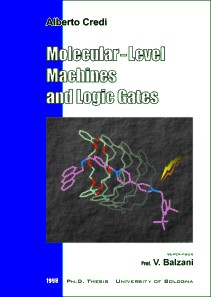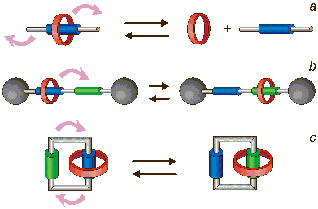Ph.D. Thesis
Title Molecular-Level Machines and Logic Gates
Adviser Prof. Vincenzo Balzani
Thesis Committee Prof. Goffredo Rosini (chairman), Dipartimento
di Chimica Organica "A. Mangini", Universit� di Bologna.; Prof. Walther
Caminati, Dipartimento di Chimica "G. Ciamician", Universit� di Bologna;
Prof. Alberto Juris, Dipartimento di Chimica "G. Ciamician", Universit�
di Bologna.
Essay
 |
ESSAY FROM THE THESIS
Molecular-Level Machines and Logic Gates
by Alberto Credi
Supervisor: Prof. V. Balzani
UNIVERSITY OF BOLOGNA, ITALY
From
macroscopic devices
to molecular machines
|
In everyday life we make extensive use of macroscopic
devices. A macroscopic device is an assembly of components designed
to achieve a specific function. Each component of the device performs
a simple act, while the entire device performs a more complex function,
characteristic of the assembly.
In recent years it has been shown that the concept of
device can be extended to the molecular level. A molecular-level device
can be defined as an assembly of a discrete number of molecular components
(that is, a supramolecular structure) designed to achieve a specific
function. Each molecular component performs a single act, while the
entire supramolecular structure performs a more complex function,
which results from the cooperation of the various molecular components.
Molecular-level devices operate via electronic and/or
nuclear rearrangements, and like macroscopic devices they need energy
to operate and signals to communicate with the operator. Light is
the most important answer to this dual requirement, as shown by Nature
where photons are used as energy by the devices responsible for photosynthetic
processes and as signals by the devices responsible for vision-related
processes. In the same way, in artificial supramolecular systems photons
can be used to cause (by photochemical reactions) and to monitor (by
absorption and emission spectroscopy) the occurrence of electronic
and nuclear rearrangements. Electrochemistry is also very useful to
cause and monitor the occurrence of electronic and nuclear rearrangements
in molecular and supramolecular systems.
Two kinds of macroscopic devices play a very important
role in our civilization: mechanical machines and electronic
computers. The aim of this Ph. D. work was to develop prototypes
of molecular-level machines and components (in particular, molecular
logic gates) related to the construction of molecular-based chemical
computers.
|
Pseudorotaxanes,
rotaxanes
|
| |
and
catenanes
|
| |
|
as
molecular-scale machines
|
Because of their structure, interlocked molecules such
as catenanes and rotaxanes, and their precursor complexes, the pseudorotaxanes,
are particularly attracting for the construction of molecular-level
machines, as motions of their molecular components can be easily imagined
(Figure 1). The preparation of these chemical systems, however, requires
a deep understanding of self-assembly and self-organizational processes
and their coupling with covalent synthetic methods. The present work
was performed in the frame of an extremely fruitful, interactive and
long-lasting collaboration with Professor J. Fraser Stoddart and his
co-workers, who are responsible for the synthesis and structural characterization
of nearly all the systems described in the thesis. The Candidate's
credits in this collaborative work include the design of the systems
(see below), the photophysical, photochemical and electrochemical
studies in solution, and all the experiments aimed to operate the
supramolecular species as molecular machines.

Figure 1. Schematic representation of the
motions that can take place between the components of pseudorotaxanes
(a), rotaxanes (b) and catenanes (c).
One of the main messages of this work is that a careful
design is needed for the construction of a molecular-scale device.
In other words, the structure and functions of supramolecular species
has to be 'programmed' through the appropriate selection of the molecular
components and of the molecular subunits they contain. During this
Ph.D. work, the features of a number of groups or units suitable for
incorporation in pseudorotaxanes, rotaxanes and catenanes have been
investigated. Such units constitute a sort of 'molecular meccano set'
from which the 'pieces' presenting suitable properties for the preparation
of a supermolecule with a desired functionality were chosen by time
to time. This is particularly true and immediate for pseudorotaxanes,
as they were obtained simply by mixing in solution a macrocyclic and
a thread-like component with complementary stereoelectronic properties.
A large part of the thesis deals with the photochemical
and electrochemical behavior of families of catenanes and rotaxanes.
Some of these systems have not been designed with the aim of producing
molecular-scale devices, but rather to understand the intercomponent
interaction that one must be able to control for making molecular
machines work. Some other have revealed not to be good prototypes
of molecular machines or information-processing systems, and may be
considered as 'failures' on the way to the construction of such molecular
devices. This testifies that, despite the progresses made, the design
and preparation of a 'working' molecular device is still a difficult
task. Also, the importance of photochemical and electrochemical methods
in supramolecular science has been clearly demonstrated.
The major accomplishment of this work is certainly the
development of many examples of chemically, photochemically or electrochemically-driven
motion in pseudorotaxanes, rotaxanes and catenanes, namely (i) the
threading/dethreading of pseudorotaxanes (Figure 1a), (ii) the shuttling
of the ring component between two 'stations' in rotaxanes (Figure
1b), and (iii) the rotation of one ring with respect to the other
in asymmetric catenanes (Figure 1c).
During these studies, it has become evident that suitably
designed molecular-level machines can be employed to perform functions
that go well beyond the mechanical movements. Such functions mimick
those performed by the components of macroscopic electronic devices,
and include logic operations, plug-in-socket, and multi-pole switching.
Particularly worth of note are pseudorotaxanes which behave as an
acid/base-operated plug-in-socket device for the photoinduced flow
of energy, and as a three-pole supramolecular switch. Even more interesting
are chemical systems, again based on pseudorotaxanes, which are responsive
to acid/base or oxidative/reductive stimulation according to the XOR
logic function.
Perspectives
The expertise gained with the present work has stimulated
ideas on the development of new and more interesting molecular devices
and on their possible applications. Some of these ideas are illustrated
in the last part of the dissertation. Such systems could also play
a role in the emerging field of nanoscience, with particular reference
to the small-upward (bottom-up) approach to nanostructures.
It is very difficult to foresee if and when this kind
of molecular-scale devices will come onto the scene and change our
lives as macroscopic machines and computers did. It is evident, however,
that the progresses made in the past few years are enormous; this
Ph. D. work has contributed, of course to a little extent, to such
advances.
Full-text PDF files can be downloaded
from <http://www.ciam.unibo.it/photochem.html/acphd.html>

